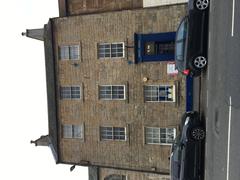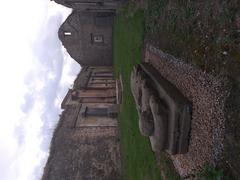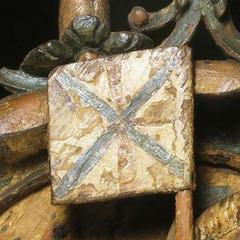West Calder East End War Memorial Visiting Hours, Tickets, and Historical Sites Guide
Date: 14/06/2025
Introduction
The West Calder East End War Memorial, located in the historic heart of West Lothian, Scotland, stands as a profound tribute to the men and women from the community who gave their lives in the First and Second World Wars and subsequent conflicts. Prominently situated at the junction of East End and Harburn Road in West Calder village near Livingston, the memorial is both a focal point for remembrance and a symbol of the region’s heritage. Its dignified architecture, community-centered ceremonies, and accessible setting make it a compelling destination for visitors interested in history, culture, and local identity (West Lothian Council, War Memorials Trust).
This guide offers a comprehensive overview, including historical context, architectural features, visitor information, and recommendations for nearby attractions, ensuring a meaningful and well-informed experience.
Historical Background
West Calder’s Early History
West Calder’s origins stretch back to medieval Scotland, initially as part of the Calder-Comitis parish. The village’s ecclesiastical history began in the 12th century with the church’s association to Dunfermline Abbey, before West Calder became an independent parish in 1643 with the construction of its own church.
Industrial Growth and Community Development
The discovery of oil shale by James Young in the 1860s transformed West Calder into a bustling industrial center. The oil shale industry brought prosperity and innovation, such as early adoption of electric street lighting, and fostered significant political activity, including visits from national figures.
Military Heritage
West Calder played a prominent role in both World Wars. The local drill hall served as a base for the Royal Scots during World War I, and the impact of conflict is deeply felt and commemorated by the War Memorial.
West Calder War Memorial: Design, Dedication, and Community Significance
Architectural Design
The memorial is a striking example of early 20th-century commemorative architecture. Designed in the classical style by Sir Robert Lorimer, it features a tall granite obelisk rising from a square plinth, symbolizing endurance and solemnity. Locally quarried granite ensures durability and regional resonance (Dictionary of Scottish Architects). The structure stands approximately 5.5 meters high and is adorned with bronze plaques listing the names of the fallen and carved laurel wreaths—a classical symbol of honor.
Dedication and Inscriptions
The main inscription reads:
“To the Glory of God and in Memory of the Men of West Calder Parish who gave their lives in the Great War 1914–1919 and the World War 1939–1945.”
Names are arranged alphabetically by conflict, ensuring equal honor for all.
Community Role
Since its unveiling in 1921 by General Sir Francis Davies, the memorial has served as the centerpiece of annual Remembrance Day ceremonies and other commemorative events. Its central location and peaceful garden setting provide a space for collective reflection and intergenerational remembrance (West Lothian Remembers).
Conservation
Ongoing conservation, supported by the War Memorials Trust and local groups, ensures the memorial’s preservation through regular cleaning, restoration, and landscaping (War Memorials Trust).
Visiting Information
Location and Accessibility
- Address: Junction of East End and Harburn Road, West Calder, West Lothian, EH55 8AB
- Access: The site is a short walk from the village center and opposite the Carnegie library.
- Wheelchair Access: Level paths and paved areas ensure accessibility for all visitors.
Visiting Hours and Admission
- Hours: Open 24 hours a day, year-round
- Admission: Free of charge
Guided Tours and Events
- While there are no regularly scheduled guided tours, local heritage groups occasionally organize historical walks. The main annual event is the Remembrance Sunday ceremony each November (Royal British Legion Scotland).
Travel Tips
- By Rail: West Calder railway station is less than 1 km from the memorial, with direct services to Edinburgh and Glasgow.
- By Bus: Local routes connect West Calder, Livingston, and nearby villages.
- Parking: Limited on-street parking is available in the village center; public transport is recommended during major events.
- Amenities: Cafés, shops, and public restrooms are available nearby. The West Calder Library offers local history resources (West Lothian Libraries).
Symbolism and Artistic Elements
- Obelisk: Symbolizes endurance and the lasting memory of those who served (Historic Environment Scotland).
- Laurel Wreaths and Sword Motifs: Reflect classical ideals of honor, sacrifice, and military valor.
- Personalized Plaques: Individual names transform the memorial into a local archive of sacrifice.
Educational Value and Digital Resources
The memorial is a vital educational resource, connecting younger generations with local history and the realities of conflict. Schools and historical societies frequently use the site for projects. For those unable to visit in person, digital archives and virtual tours are available via the council and heritage organizations (West Lothian Remembers).
Nearby Historical Sites and Attractions
- Old Parish Church Ruins: Connects visitors to West Calder’s ecclesiastical past.
- Five Sisters Zoo: Family-friendly zoo located nearby (Five Sisters Zoo).
- Shale Trail: A 16-mile walking/cycling route exploring West Calder’s industrial heritage.
- Burngrange Pit Disaster Memorial: Dedicated to the miners lost in 1947, offering further historical context.
- Almond Valley Heritage Centre: Local museum with interactive exhibits on rural and industrial history (Almond Valley Heritage Centre).
- Livingston Designer Outlet and Almondvale Centre: Shopping and leisure in nearby Livingston (Livingston Designer Outlet).
Practical Visitor Information
Transportation
- Rail: West Calder and Addiewell stations serve the area.
- Bus: Frequent services connect West Calder, Livingston, and outlying villages.
- Taxi and Rideshare: Readily available in Livingston.
Local Amenities
- Accommodation: Options range from budget hotels to historic inns (Livingston Inn).
- Dining: Cafés, restaurants, and pubs are plentiful, particularly near the Almondvale Centre.
- Wellness: Nearby spa facilities such as Macdonald Houstoun House Spa.
Outdoor and Recreation
- Almondell & Calderwood Country Park: Woodland walks and wildlife.
- Eliburns Park: Family-friendly green space.
- Union Canal: Opportunities for walking, cycling, and boating.
Sports and Leisure
- Livingston Football Club: Scottish Premier League matches at the Tony Macaroni Stadium.
- Xcite Livingston: Modern leisure centre with pool and gym.
Accessibility & Tips
- Accessibility: Most major attractions are wheelchair-friendly.
- Weather: Prepare for variable Scottish weather; layers and rain gear are recommended.
- Currency: British Pound (GBP); cards widely accepted.
Frequently Asked Questions (FAQs)
Q: What are the West Calder War Memorial’s visiting hours?
A: The memorial is accessible 24/7, year-round.
Q: Is there an admission fee or ticket required?
A: No, the site is free to visit.
Q: Are guided tours available?
A: Not regularly, but local heritage groups sometimes offer historical walks.
Q: Is the memorial accessible for visitors with disabilities?
A: Yes, with level paved paths and ramps.
Q: Are there nearby attractions?
A: Yes—Five Sisters Zoo, Almond Valley Heritage Centre, Shale Trail, and more.
Q: Is public transport available?
A: Yes, both bus and train services connect West Calder and Livingston.
Summary and Call to Action
The West Calder East End War Memorial is a solemn and inspiring landmark, deeply woven into the fabric of West Lothian’s community life. Its classical obelisk design, meaningful inscriptions, and central role in remembrance events create a powerful space for reflection. Open year-round and freely accessible, the memorial welcomes all visitors, while its proximity to historical sites and modern amenities in Livingston make West Calder an excellent destination for history, culture, and recreation.
Plan your visit by consulting official resources, and enrich your experience with digital guides such as the Audiala app. Stay connected with local heritage news and events for a deeper appreciation of West Lothian’s enduring legacy.
For further details and official sources, see:
- West Lothian Council War Memorials page
- War Memorials Trust Grants and Publications
- Dictionary of Scottish Architects: Sir Robert Lorimer
- VisitScotland – West Calder and Livingston
- Livingstoni – Livingston Tourist Attractions
- West Calder War Memorial Restoration Article – West Lothian Courier
- Historic Environment Scotland Listing
- My Voyage Scotland – Livingston Attractions
- War Memorials Trust Publication on Cultural Significance


